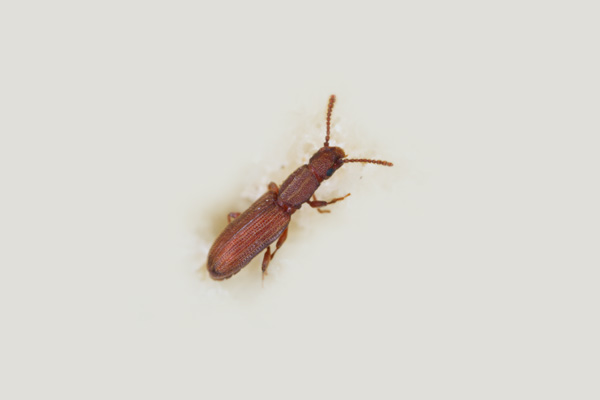 Welcome to the official website of Pony Shanghai Termite Control Center!
Welcome to the official website of Pony Shanghai Termite Control Center!
 Tel:021-56180668
Tel:021-56180668
 E-mail: ponypco@163.com
E-mail: ponypco@163.com
Saw valley thief is an insect of the family Saw valley thief in the order Coleoptera. Adults are flattened, elongated, and elliptical in shape, dark brown in color, measuring 2.5-3.5 millimeters in length, and covered in dense yellow brown hairs. The head is trapezoidal in shape, with black protruding compound eyes and 11 rod-shaped antennae; The anterior thoracic dorsal plate is oval in shape, with three longitudinal ridges in the middle and six serrated protrusions on each side; The elytra are long, nearly parallel on both sides, and rounded at the posterior end. There are longitudinal engraved points and four longitudinal ridges on the wing surface, and the male insect has one pointed tooth on the underside of the hind leg joint. The larvae are flat and slender, with a body length of 3-4 millimeters, gray white in color, and long antennae and heads. They have 3 segments, with the third segment being twice the length of the second segment. There are 3 pairs of thorax and foot, and there is a dark brown nearly square spot on both sides of the back of each segment of the thorax. A brown semi-circular to elliptical spot is horizontally arranged in the middle of the back of each segment of the abdomen.

Sawmilling bandits are distributed all over the world, with known distribution areas in China including Hebei, Shanxi, Inner Mongolia, Heilongjiang, Liaoning, Shaanxi, Gansu, Xinjiang, Shandong, Henan, Jiangsu, Zhejiang, Anhui, Fujian, Jiangxi, Sichuan, Hubei, Hunan, Guangdong, Guangxi, Yunnan and other provinces (regions). Mainly overwintering by flying adult insects to nearby rocks, bark, and other places outdoors. The following year, they flew back indoors, and a few adult insects stayed in the gaps of the grain storage room to overwinter. Adults are lively, prefer to gather in groups, have strong cold resistance, and tend to gather on the surface of grain piles. Harmless to the human body. The sawmill beetle has 2-5 generations per year, with each female laying an average of about 70 eggs, and some can reach up to 375 eggs. The eggs are mostly found in debris, and the larvae are active and have a tendency to feign death.
Sawing grain thieves are important pests in grain storage. Hosts include rice, wheat, flour, dried fruits, medicinal herbs, grains, beans, flour, dried fruits, medicinal herbs, tobacco, various dried meats, starch, etc. Adults and nymphs prefer to eat broken grains or powder scraps of grains such as corn. When harmful to edible fungi, larvae feed on dried fruiting bodies, and adults can also cause harm.
Sawing Valley Thief, also known as Sawing Chest Valley Thief, feeds on dried mushrooms such as shiitake mushrooms, grass mushrooms, shiitake mushrooms, tea leaf mushrooms, monkey head mushrooms, and fungus with larvae or adults.
[Artificial Prevention and Control]
(1) Ensure proper storage: When tobacco leaves are stored, strict re drying is carried out to kill the grain thieves before storage.
(2) Pay attention to the hygiene inside the warehouse: Before storing cigarettes, be sure to clean the warehouse, block the gaps, and paint them; The scattered smoke and dust that are cleaned up shall be burned with fire. Equipment, tools, loading and unloading, and transportation devices should be treated with insecticides before use.
(3) Isolation and pest control: Systematically store insect infested tobacco leaves separately from insect free tobacco leaves, new tobacco leaves from aged tobacco leaves, and long-term storage and preparation for external transfer tobacco leaves to prevent cross harm.
[Physical Prevention and Control]
(1) The high-temperature method can choose to sun dry the grain on sunny days, usually 3-5 centimeters thick, and flip it every half an hour to raise the grain temperature to 50 ℃, and then maintain it continuously for 4-6 hours. The higher the grain temperature, the better the insecticidal effect. When drying grains, pesticides such as dichlorvos should be sprayed at a distance of 2 meters from the grains around the site to prevent pests from escaping.
(2) Most stored grain pests can freeze to death when kept below 0 ℃ for a certain period of time. In winter in the north, when the temperature reaches below -10 ℃, the stored grain is spread out, usually 7-10 centimeters thick. After 12 hours of freezing, the pests inside the stored grain can be killed. If the temperature cannot reach -10 ℃, the freezing time needs to be extended. Frozen grains need to be stored in a sealed container while they are cold. Seed grains and peanuts with a moisture content of less than 17% cannot be frozen, while other grains and oilseeds can be frozen using this method.
[Drug prevention and control]
56% aluminum phosphide tablets and pills can be used for fumigation. The dosage for cigarette stacks is 6-9g/m3, and the dosage for equipment is 4-7g/m3. After spraying, seal for 3-5 days, and after fumigation, ventilate for at least 4 days. (Specific methods should be carried out in accordance with relevant operating procedures). In addition, pesticides such as bromomethane or dichlorvos can also be used for fumigation or empty storage to kill insects during the storage period.

Scan and follow us
Pony Termite Control Center
Tel:021-56180668
Wechat:ponyguard
E-mail:ponypco@163.com
Address:Room 102, Building 90, 388 Lianyi Road, Shanghai, China
Sydney, Australia Address:40 Strathalbyn drive Oatlands
Sydney, Australia Tel:0411314731
Contact us for free pest control solutions
Copyright Shanghai Pony Environmental Technology Co., Ltd Record number:沪ICP备19045686号-1











